A. G. Vanakaras, M. A. Bates and D. J. Photinos, Phys. Chem. Chem. Phys. 5(17), 3700 (2003).
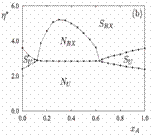 Abstract: Variational cluster calculations and Monte Carlo simulations are applied to hard-body board-like models of biaxial molecules forming liquid crystalline phases. The molecular long axes are assumed for simplicity to be fully oriented. Depending on the extent of transverse anisometry in the molecular shape, these systems can exhibit biaxial nematic phases as well as uniaxial and biaxial orthogonal smectic phases. It is shown that the region of thermodynamic stability for the biaxial nematic phase is considerably broadened in binary mixtures of molecules with the same cross section but differing in their long dimension.
Abstract: Variational cluster calculations and Monte Carlo simulations are applied to hard-body board-like models of biaxial molecules forming liquid crystalline phases. The molecular long axes are assumed for simplicity to be fully oriented. Depending on the extent of transverse anisometry in the molecular shape, these systems can exhibit biaxial nematic phases as well as uniaxial and biaxial orthogonal smectic phases. It is shown that the region of thermodynamic stability for the biaxial nematic phase is considerably broadened in binary mixtures of molecules with the same cross section but differing in their long dimension.
A. Galindo, A. J. Haslam, S. Varga, G. Jackson, A. G. Vanakaras, D. J. Photinos and D. A. Dunmur, J. Chem. Phys. 119(10), 5216 (2003).
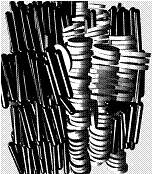 Abstract: The phase behavior of a binary mixture of rodlike and disclike hard molecules is studied using Monte Carlo NVT computer simulation. The rods are modeled as hard spherocylinders of aspect ratio L-HSC/D-HSC=5, and the discs as hard cut spheres of aspect ratio L-CS/D-CS=0.12. The diameter ratio D-CS/D-HSC=3.62 is chosen such that the molecular volumes of the two particles are equal. The starting configuration in the simulations is a mixed isotropic state. The phase diagram is mapped by changing the overall density of the system. At low densities stabilization of the isotropic phase relative to the ordered states is seen on mixing, and at high densities nematic-columnar and smectic A-columnar phase coexistence is observed. Biaxiality in the nematic phase is not seen. The phase diagram of the mixture is also calculated using the second virial theory of Onsager for nematic ordering, together with the scaling of Parsons and Lee to take into account the higher virial coefficients. The disc-disc and rod-disc excluded volumes are evaluated numerically using the exact overlap expressions, and the lower-order end-effects are incorporated. The exact rod-rod excluded volume is known analytically. In the case of the theoretical calculations, which are limited to translationally disordered phases, coexistence between two uniaxial nematic phases is predicted, as well as the stabilization of the disc-rich isotropic phases. As found in the simulation, biaxial nematic phases are not predicted to be stable. The phase equilibria of an experimental system is also reported which exhibits a behavior close to the system studied by computer simulation. As in the model mixtures, this system exhibits a marked destabilization of the ordered phases on mixing, while nematic-columnar demixing is observed at lower temperatures (the higher-density states).
Abstract: The phase behavior of a binary mixture of rodlike and disclike hard molecules is studied using Monte Carlo NVT computer simulation. The rods are modeled as hard spherocylinders of aspect ratio L-HSC/D-HSC=5, and the discs as hard cut spheres of aspect ratio L-CS/D-CS=0.12. The diameter ratio D-CS/D-HSC=3.62 is chosen such that the molecular volumes of the two particles are equal. The starting configuration in the simulations is a mixed isotropic state. The phase diagram is mapped by changing the overall density of the system. At low densities stabilization of the isotropic phase relative to the ordered states is seen on mixing, and at high densities nematic-columnar and smectic A-columnar phase coexistence is observed. Biaxiality in the nematic phase is not seen. The phase diagram of the mixture is also calculated using the second virial theory of Onsager for nematic ordering, together with the scaling of Parsons and Lee to take into account the higher virial coefficients. The disc-disc and rod-disc excluded volumes are evaluated numerically using the exact overlap expressions, and the lower-order end-effects are incorporated. The exact rod-rod excluded volume is known analytically. In the case of the theoretical calculations, which are limited to translationally disordered phases, coexistence between two uniaxial nematic phases is predicted, as well as the stabilization of the disc-rich isotropic phases. As found in the simulation, biaxial nematic phases are not predicted to be stable. The phase equilibria of an experimental system is also reported which exhibits a behavior close to the system studied by computer simulation. As in the model mixtures, this system exhibits a marked destabilization of the ordered phases on mixing, while nematic-columnar demixing is observed at lower temperatures (the higher-density states).
R. Berardi, S. Orlandi, D. J. Photinos, A. G. Vanakaras and C. Zannoni, Phys. Chem. Chem. Phys. 4(5), 770 (2002).
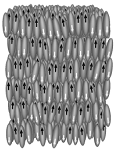 Abstract: We study the effect of molecular dipole strength on the polymorphism of smectic A liquid crystals using computer simulations and density functional theory. We find, for a system of polar Gay-Berne particles with an off-centre axial dipole, a change in molecular organisation from non-interdigitated to interdigitated (S-Ad) structure.
Abstract: We study the effect of molecular dipole strength on the polymorphism of smectic A liquid crystals using computer simulations and density functional theory. We find, for a system of polar Gay-Berne particles with an off-centre axial dipole, a change in molecular organisation from non-interdigitated to interdigitated (S-Ad) structure.
P. K. Karahaliou, A. G. Vanakaras and D. J. Photinos, Phys. Rev. E, 65, 031712 (2002).
 Abstract: The order parameters for the phenomenological description of the smectic-A to smectic-C phase transition are formulated on the basis of molecular symmetry and structure. It is shown that, unless the long molecular axis is an axis of twofold or higher rotational symmetry, the ordering of the molecules in the smectic-C phase gives rise to more than one tilt order parameter and to one or more polar order parameters. The latter describe the indigenous polarity of the smectic-C phase, which is not related to molecular chirality but underlies the appearance of spontaneous polarization in chiral smectics. A phenomenological theory of the phase transition is formulated by means of a Landau expansion in two tilt order parameters (primary and secondary) and an indigenous polarity order parameter. The coupling among these order parameters determines the possibility of sign inversions in the temperature dependence of the spontaneous polarization and of the helical pitch observed experimentally for some chiral smectic-C* materials. The molecular interpretation of the inversion phenomena is examined in the light of this formulation.
Abstract: The order parameters for the phenomenological description of the smectic-A to smectic-C phase transition are formulated on the basis of molecular symmetry and structure. It is shown that, unless the long molecular axis is an axis of twofold or higher rotational symmetry, the ordering of the molecules in the smectic-C phase gives rise to more than one tilt order parameter and to one or more polar order parameters. The latter describe the indigenous polarity of the smectic-C phase, which is not related to molecular chirality but underlies the appearance of spontaneous polarization in chiral smectics. A phenomenological theory of the phase transition is formulated by means of a Landau expansion in two tilt order parameters (primary and secondary) and an indigenous polarity order parameter. The coupling among these order parameters determines the possibility of sign inversions in the temperature dependence of the spontaneous polarization and of the helical pitch observed experimentally for some chiral smectic-C* materials. The molecular interpretation of the inversion phenomena is examined in the light of this formulation.
A. G. Vanakaras and D. J. Photinos, J. of Mater. Chem., 11(11), 2832-2838 (2001).
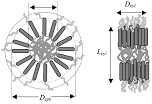 Abstract: A molecular description of the mesomorphic behaviour of globular supermolecules of radial dendritic architecture is presented. It is based on coarse grained structural and conformational features, namely, anisometry of the overall shape, submolecular partitioning of the interactions and non-convexity of the supermolecular surface. The relevance of these features to conformational phase transitions, orientational ordering, layering and microsegregation phenomena in ordered fluid phases is studied using density functional theory of deformable bodies and Monte Carlo simulations of rigid fan molecules. Orientationally ordered and layered phases are found, both in theory and simulation, even in the absence of significant overall shape anisometry.
Abstract: A molecular description of the mesomorphic behaviour of globular supermolecules of radial dendritic architecture is presented. It is based on coarse grained structural and conformational features, namely, anisometry of the overall shape, submolecular partitioning of the interactions and non-convexity of the supermolecular surface. The relevance of these features to conformational phase transitions, orientational ordering, layering and microsegregation phenomena in ordered fluid phases is studied using density functional theory of deformable bodies and Monte Carlo simulations of rigid fan molecules. Orientationally ordered and layered phases are found, both in theory and simulation, even in the absence of significant overall shape anisometry.
A. G. Vanakaras, A. F. Terzis and D. J. Photinos, Molec.Cryst. Liq. Cryst., 362, 67-78 (2001).
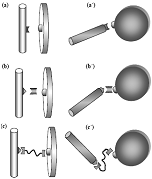 Abstract: A nematic consisting of rod-like and plate-like molecular species is expected to exhibit phase biaxiality over a range of concentrations. Phase separation, however, prevents the achievement of such concentrations in mixtures of conventional, low molar mass, thermotropic calamitic and discotic mesogens. We present a theoretical study of the molecular requirements for phase biaxiality in three types of rod-plate nematics, namely in (i) binary mixtures of hard rods and discs, (ii) mixtures of rods and discs exhibiting molecular association, either by direct rod-disc interaction or through selective interactions with a third molecular species and (iii) single component systems with interconverting rod-like and plate-like conformations.
Abstract: A nematic consisting of rod-like and plate-like molecular species is expected to exhibit phase biaxiality over a range of concentrations. Phase separation, however, prevents the achievement of such concentrations in mixtures of conventional, low molar mass, thermotropic calamitic and discotic mesogens. We present a theoretical study of the molecular requirements for phase biaxiality in three types of rod-plate nematics, namely in (i) binary mixtures of hard rods and discs, (ii) mixtures of rods and discs exhibiting molecular association, either by direct rod-disc interaction or through selective interactions with a third molecular species and (iii) single component systems with interconverting rod-like and plate-like conformations.
A. G. Vanakaras and D.J. Photinos,
Chem. Phys. Lett.,
341(1-2), 129-134 (2001).
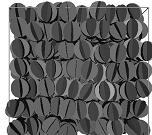 Abstract: We have used Monte Carlo (MC) NPT computer simulations to study a system of spherical-fan-shaped particles made of three hard discs fused along a common diameter. The calculated equation of state indicates a strong, entropy driven. first-order transition from the isotropic phase to a layered phase that has the basic characteristics of the usual smectic-A mesophase but with strongly correlated rotations about the symmetry axes of neighbouring molecules.
Abstract: We have used Monte Carlo (MC) NPT computer simulations to study a system of spherical-fan-shaped particles made of three hard discs fused along a common diameter. The calculated equation of state indicates a strong, entropy driven. first-order transition from the isotropic phase to a layered phase that has the basic characteristics of the usual smectic-A mesophase but with strongly correlated rotations about the symmetry axes of neighbouring molecules.
A. F. Terzis, A. G. Vanakaras and D.J. Photinos,
Molec.Cryst. Liq. Cryst.,
352, 699-708 (2000).
Abstract: We investigate theoretically the liquid crystalline phase behaviour of globular dendrimers consisting of a soft inner scaffold and peripheral mesogenic units attached to the scaffold by means of flexible chains. We use a generalised Onsager molecular theory to analyse model systems exhibiting conformational rod-sphere and rod-disc interconversions. Phase transitions normally not encountered in low molar mass mesogens are reported. For a system with spherical lowest energy conformation a thermotropic re-entrance to the isotropic phase is observed.
A. F. Terzis, A. G. Vanakaras and D.J. Photinos, Molec.Cryst. Liq. Cryst., 330, 1761-1768 (1999).
 Abstract: We present a simple statistical theory of anisotropic fluid phases consisting of deformable molecules and we use it to describe the self-organization of liquid crystalline dendrimers in the limit of very densely attached mesogenic units. We perform calculations for model-systems of spherical molecules that can deform into rod-like or disc-like states and we determine their mesomorphic range as a function of molecular shape parameters and intrinsic conformational probability.
Abstract: We present a simple statistical theory of anisotropic fluid phases consisting of deformable molecules and we use it to describe the self-organization of liquid crystalline dendrimers in the limit of very densely attached mesogenic units. We perform calculations for model-systems of spherical molecules that can deform into rod-like or disc-like states and we determine their mesomorphic range as a function of molecular shape parameters and intrinsic conformational probability.
A. G. Vanakaras, D.J. Photinos and E. T. Samulski, Phys. Rev. E, 57(5), R4875-R4878 (1998).
 Abstract: We show through explicit molecular modeling how tilt may be induced in layered mesophases and propagate across the-layers, using a concrete representation of flexible tail-core-tail calamitic mesogens in conjunction with-the variational cluster expansion. The results demonstrate that spontaneous symmetry breaking observed in smectic-liquid crystals-the tilt of the director relative to the layers-can be induced by excluded. volume interactions, both in the synclinic and in the anticlinic configurations.
Abstract: We show through explicit molecular modeling how tilt may be induced in layered mesophases and propagate across the-layers, using a concrete representation of flexible tail-core-tail calamitic mesogens in conjunction with-the variational cluster expansion. The results demonstrate that spontaneous symmetry breaking observed in smectic-liquid crystals-the tilt of the director relative to the layers-can be induced by excluded. volume interactions, both in the synclinic and in the anticlinic configurations.
 Abstract: Variational cluster calculations and Monte Carlo simulations are applied to hard-body board-like models of biaxial molecules forming liquid crystalline phases. The molecular long axes are assumed for simplicity to be fully oriented. Depending on the extent of transverse anisometry in the molecular shape, these systems can exhibit biaxial nematic phases as well as uniaxial and biaxial orthogonal smectic phases. It is shown that the region of thermodynamic stability for the biaxial nematic phase is considerably broadened in binary mixtures of molecules with the same cross section but differing in their long dimension.
Abstract: Variational cluster calculations and Monte Carlo simulations are applied to hard-body board-like models of biaxial molecules forming liquid crystalline phases. The molecular long axes are assumed for simplicity to be fully oriented. Depending on the extent of transverse anisometry in the molecular shape, these systems can exhibit biaxial nematic phases as well as uniaxial and biaxial orthogonal smectic phases. It is shown that the region of thermodynamic stability for the biaxial nematic phase is considerably broadened in binary mixtures of molecules with the same cross section but differing in their long dimension.






